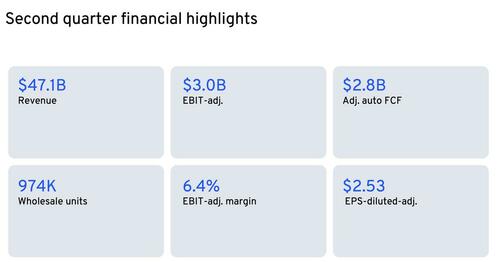General Motors reported second-quarter earnings that surpassed analyst expectations, even as the automaker absorbed a $1.1 billion hit from tariffs – but it also warned about a coming steeper impact from tariffs moving into the second half of the year.
Strong U.S. demand for gasoline-powered trucks and SUVs helped bolster results, but the company warned tariff headwinds will intensify in the third quarter, according to Reuters and the company earnings report. GM maintained its estimate that tariffs could cost between $4 billion and $5 billion this year.
The company said it aims to mitigate at least 30% of that impact through cost-cutting and strategic adjustments. Despite the earnings beat, shares were down more than 7% heading into the end of Tuesday’s trading day.
Revenue for the quarter ending June 30 dropped nearly 2% from a year earlier to about $47 billion. Adjusted earnings per share declined to $2.53 from $3.06 but still exceeded analyst forecasts of $2.44, according to LSEG. Adjusted EBIT fell 32% to $3 billion.
In her letter to shareholders, CEO Mary Barra emphasized GM’s resilience, stating:
“We are positioning the business for a profitable, long-term future as we adapt to new trade and tax policies, and a rapidly evolving tech landscape.”
Despite the drag from tariffs, GM’s core business remained strong. U.S. vehicle sales — its main profit center — rose 7%, driven by high demand for pickups and SUVs. The company also swung to a small profit in China, after losses a year earlier, supported by growing sales of new energy vehicles.
“In China, the performance of our new energy vehicles has been especially strong,” Barra noted. “We gained the most share among foreign OEMs, and we reported positive equity income.”
Barra also highlighted the strength of GM’s crossover lineup and full-size models:
“In the United States, we continue to lead the industry in full-size trucks and SUVs… resulting in record demand and revenue growth.”
The automaker reaffirmed its full-year forecast of adjusted core profit between $10 billion and $12.5 billion, unchanged from earlier guidance despite escalating trade pressure.
To strengthen its domestic manufacturing base and reduce import exposure, GM announced $4 billion in new U.S. factory investments in June. The plan will expand capacity by 300,000 units across key high-margin models — pickups, SUVs, and crossovers — at plants in Michigan, Kansas, and Tennessee.
“This will help us satisfy unmet customer demand, greatly reduce our tariff exposure, and capture upside opportunities as we launch new models,” Barra wrote.
Currently, GM imports about half the vehicles it sells in the U.S., primarily from Mexico and South Korea. In contrast, rival Ford produces about 80% of its U.S. vehicles domestically. Ford is expected to report second-quarter earnings next week.
Meanwhile, Stellantis, which owns Jeep, said tariffs cost it €300 million in the first half of the year and warned that results in the second half of 2025 will be significantly affected. Shares in Stellantis and Ford both fell about 1% on Tuesday morning.
Amid growing uncertainty in the EV market, GM is recalibrating its approach without backing off its long-term electrification goals. EV sales growth has slowed, and the phase-out of U.S. government tax credits — including a $7,500 incentive for new EVs and $4,000 for used models, ending in September — is expected to further dampen demand.
Nonetheless, Barra remains committed to GM’s electric future:
“Despite slower EV industry growth, we believe the long-term future is profitable electric vehicle production, and this continues to be our north star.”
She added that GM will continue leveraging its flexible manufacturing strategy and domestic battery investments to navigate the shifting landscape:
“We will prioritize our customers, brands, and a flexible manufacturing footprint… GM is well positioned to succeed in an ICE market that now has a longer runway.”
Looking forward, GM says it will focus on strengthening profitability across both its traditional and EV businesses while driving American innovation in software, batteries, and autonomous technologies.
“I believe everything we’re doing strategically and proactively… will further differentiate us from our competitors, increase our resilience, and help us emerge from this transition period even stronger and more profitable than before,” Barra concluded.
Loading…



















